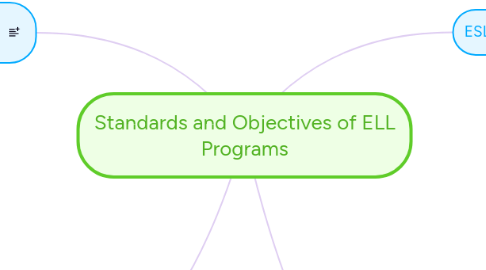
1. Two-Way Immersion/Bilingual
1.1. Objectives
1.1.1. to improve academic achievement and graduation rates of English language learners (ELLs), or students who speak a language other than English in the home
1.1.2. to support district efforts to close the academic achievement gap between ELLs and their peers
1.1.3. to develop the ability to read, write, and communicate in students' first and second languages
1.1.3.1. Supports Standards 2-5 English language learners communicate information, ideas, and concepts necessary for academic success in the area of language arts/mathematics/science/social studies
1.1.4. to prepare students for full participation in today’s interconnected and increasingly competitive global context
1.1.4.1. Supports Standard 1: English language learners communicate for social, intercultural, and instructional purposes within the school setting.
1.2. Teaching strategies
1.2.1. include language goals along with learning goals
1.2.2. use hands-on activities for students to visually see and feel new language and content
1.2.3. teach slowly and be mindful students may take a while to understand new concepts/vocabulary
1.2.4. give students as much personalized attention as possible, as each are coming from a unique background
2. Dual Language Immersion in ACTION
3. ESL Pull-Out
3.1. Objectives
3.1.1. To identify all students whose native or home language is one other than English and to assess the English language proficiency of all identified students
3.1.2. To place students in appropriate educational programs that foster maximum English and content acquisition
3.1.2.1. Supports Standards 2-5 English language learners communicate information, ideas, and concepts necessary for academic success in the area of language arts/mathematics/science/social studies
3.1.3. To regularly assess the English proficiency and academic progress of students served by the program and adjust services according to specific needs
3.1.3.1. Supports Standards 2-5 English language learners communicate information, ideas, and concepts necessary for academic success in the area of language arts/mathematics/science/social studies
3.1.4. To transition students into content classes as soon as their English proficiency makes success there possible
3.1.4.1. Supports Standards 2-5 English language learners communicate information, ideas, and concepts necessary for academic success in the area of language arts/mathematics/science/social studies
3.1.5. To provide ongoing monitoring and support for students who have exited
3.1.6. To support the curriculum and instruction of the mainstream classroom when appropriate for the developmental stages of students
3.1.6.1. Supports Standards 2-5 English language learners communicate information, ideas, and concepts necessary for academic success in the area of language arts/mathematics/science/social studies
3.2. Teaching strategies
3.2.1. give students as much individual attention as possible - each students level and vocabulary is unique
3.2.2. preplan activities/content with student's regular teacher and stay in contact to discuss any issues or successes
3.2.3. keep content as closely aligned as possible with students work in regular classrooms
3.2.4. ESL-regular teacher communication
